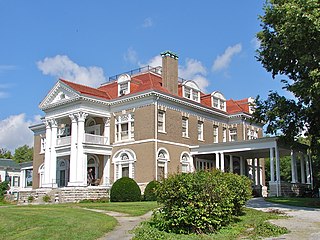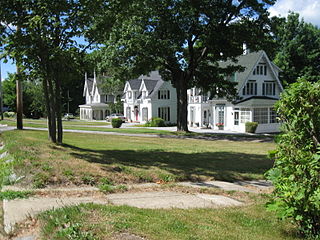
Garnett is a city in and the county seat of Anderson County, Kansas, United States. As of the 2020 census, the population of the city was 3,242.

The architecture of Kansas City encompasses the metropolitan area, anchored by Kansas City, Missouri (KCMO). Major buildings by some of the world's most distinguished architects and firms include McKim, Mead and White; Jarvis Hunt; Wight and Wight; Graham, Anderson, Probst and White; Hoit, Price & Barnes; Frank Lloyd Wright; the Office of Mies van der Rohe; Barry Byrne; Edward Larrabee Barnes; Harry Weese; and Skidmore, Owings & Merrill.

The Main Street Historic District encompasses the historic commercial center of Middletown, Connecticut, United States. Middletown was one of the most important ports on the Connecticut River during the colonial period, and Main Street "has been the center of community life since the earliest period of settlement". Today Main Street is home to a number of 19th century buildings, maintaining the bulk of its historic character. It was listed on the National Register of Historic Places in 1983.
The Wyoming Governor's Mansion is the official residence of the governor of Wyoming. The current mansion was built during 1976 in Cheyenne.

Rockcliffe Mansion is located in Hannibal, Missouri (USA) and was built in 1898 by John J. Cruikshank, Jr, a descendant of Scottish immigrants, whose fortune was founded on lumber. He erected the residence on West Bird Street. It came to be acknowledged as the most imposing, beautiful and costly residential structure in that part of the state of Missouri. "By reason of its location on a high, rocky eminence, overlooking the entire city [and the Mississippi River], it [was] termed 'Rock Cliff' [later known as "Rockcliffe"], and is one of the many attractions of the city invariably viewed by strangers and tourists visiting Hannibal." It is located in the Maple Avenue Historic District.

The Pearl Street School is a historic school building at 75 Pearl Street in Reading, Massachusetts. Built in 1939, the two-story brick and limestone building is Reading's only structure built as part of a Public Works Administration project. The site on which it was built was acquired by the town sometime before 1848, and served as its poor farm. With fifteen classrooms, the school replaced three smaller wood-frame schoolhouses in the town's school system, and was its first fire-resistant structure.

The Anderson County Courthouse, located at 4th and Oak Streets in Garnett, serves as the seat of government for Anderson County, Kansas. The courthouse was built from 1901 to 1902 by contractors Latimer & Benning, the building cost $75,000. The courthouse was designed by George P. Washburn designed the courthouse in the Romanesque Revival style.

Louis Singleton Curtiss was a Canadian-born American architect. Notable as a pioneer of the curtain wall design, he was once described as "the Frank Lloyd Wright of Kansas City". In his career, he designed more than 200 buildings, though not all were realized. There are approximately 30 examples of his work still extant in Kansas City, Missouri where Curtiss spent his career, including his best known design, the Boley Clothing Company Building. Other notable works can be found throughout the American midwest.
Shelley House may refer to:

Ferry & Clas was an architectural firm in Wisconsin. It designed many buildings that are listed on the National Register of Historic Places. George Bowman Ferry and Alfred Charles Clas were partners.

The Knight–Mangum House is a historic house located in Provo, Utah, United States. It is listed on the National Register of Historic Places. The mansion was built in the old English Tudor style, completed in 1908. It was built for Mr. W. Lester Mangum and his wife Jennie Knight Mangum. Mrs. Mangum was the daughter of the famous Utah mining man, Jesse Knight. The lot was purchased for $3,500 and the home was built at a cost of about $40,000. The Mangum family was able to afford the home due to the fact that they had sold their shares in Jesse Knight's mine located in Tintic, Utah, for eight dollars a share. They had purchased the shares for only twenty cents a share, so the excess allowed them enough funds to purchase the home. The contractors for the home were the Alexandis Brothers of Provo.
George Putnam Washburn was a prominent architect practicing in Kansas. Washburn came to Kansas in 1870, worked as a carpenter and architect, and in 1882 opened an architecture practice in Ottawa, Kansas. His son joined his firm which became George P. Washburn & Son. In 1910 George P.'s son-in-law, Roy Stookey, joined the firm, and George P. retired. After George P. died in 1922 the firm became Washburn & Stookey.
Henry Wildhagen was one of northern Wisconsin's best-known architects at the turn of the 20th century.
Carlton House is a historic Spanish Colonial Revival house located in Pine Valley of the United States Air Force Academy in Colorado Springs, Colorado. It has been used as a residence for Mrs. Albert E. Carlton, a country club called the Pine Valley Club and, among other Academy functions, a residence for the United States Air Force Academy Superintendent.

The Atchison County Courthouse, located at the southwest corner of 5th and Parallel Streets in Atchison, is the seat of government of Atchison County, Kansas. The stone courthouse was built from 1896 to 1897 and replaced the county's first courthouse, which had been built in 1859. County officials wanted the courthouse to resemble the Franklin County Courthouse in Ottawa, so they hired that building's architect, George P. Washburn, to design the new courthouse. Washburn designed the building in the Romanesque Revival style. The courthouse's design features four corner towers, including a seven-story clock tower. The main entrance to the courthouse has a porch within a large arch; the doorway is contained in a smaller arch. The building has a hip roof with intersecting gable dormers; the towers have pyramidal roofs.

The Hinckley Hill Historic District encompasses a well-preserved collection of stylish mid-19th century residences in Calais, Maine. Built mostly between 1820 and 1860, it includes a trio of high-quality Gothic Revival houses from the 1850s near the eastern edge of the town. The district was listed on the National Register of Historic Places in 1994.
George William Hellmuth (1870-1955) was an American architect based in St. Louis, Missouri.













